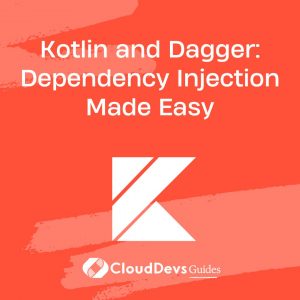Kotlin and Dagger: Dependency Injection Made Easy
Dependency injection is a crucial aspect of modern software development, as it enables the creation of loosely-coupled, scalable, and testable code. In Kotlin, a popular and expressive programming language, leveraging the benefits of dependency injection becomes even more efficient with the help of Dagger.
Dagger is a widely used dependency injection framework developed by Google, designed specifically for Java, and easily compatible with Kotlin. It significantly simplifies the process of managing dependencies in your applications, resulting in cleaner code and a more maintainable project. In this blog post, we’ll explore the basics of Dagger and demonstrate how to implement it in Kotlin projects.
1. What is Dependency Injection?
Before diving into Dagger, let’s briefly understand the concept of dependency injection. Dependency injection is a design pattern that allows the inversion of control in an application. Instead of a class creating its own dependencies, these dependencies are “injected” from external sources, such as a container or framework. This promotes loose coupling, making the code more modular, reusable, and easier to test.
2. Why Use Dagger?
While Kotlin offers numerous features to simplify code development, managing dependencies can still be challenging. Dagger addresses this issue by providing the following benefits:
- Compile-time Safety: Dagger performs dependency injection at compile-time, enabling early detection of potential issues. This reduces the likelihood of runtime errors and enhances code reliability.
- Performance Optimization: Dagger’s generated code is highly optimized, leading to faster execution times compared to traditional runtime reflection-based dependency injection frameworks.
- Scalability and Maintainability: With Dagger, your codebase becomes more organized and easier to manage, especially as the project scales. It encourages a clear separation of concerns and simplifies debugging.
- Testing Made Easy: Dependency injection enhances testability. By injecting mock objects, you can easily isolate and test individual components of your application.
3. Getting Started with Dagger in Kotlin
Now that we understand the benefits of Dagger, let’s set it up in a Kotlin project. We’ll walk through the installation process and gradually explore the core components of Dagger.
Step 1: Adding Dagger Dependencies
To begin, ensure you have a Kotlin project set up. In your project’s build.gradle file, include the following dependencies:
kotlin
dependencies {
implementation "com.google.dagger:dagger:2.39.1"
kapt "com.google.dagger:dagger-compiler:2.39.1"
}
Here, we are adding Dagger’s core library as well as the Kotlin annotation processor (kapt) for Dagger’s code generation.
Step 2: Creating Modules
Modules are essential components of Dagger that define how dependencies are provided. Each module represents a logical section of your application and groups related dependencies together. Let’s create a simple module for demonstration purposes:
kotlin
@Module
class MyModule {
@Provides
fun provideMyDependency(): MyDependency {
return MyDependency()
}
}
In this example, we define a module called MyModule, and it provides a single dependency of type MyDependency.
Step 3: Creating Components
Next, we need to create a Dagger component. Components act as bridges between modules and the classes that need access to the provided dependencies. They also specify the injection targets. Create a component like this:
kotlin
@Component(modules = [MyModule::class])
interface MyComponent {
fun inject(myClass: MyClass)
}
In this example, we define a component called MyComponent, which includes the MyModule we created earlier. We also declare an inject method that takes an instance of MyClass.
Step 4: Performing Injection
Now that our module and component are set up, we can use Dagger to inject dependencies into our classes. Let’s see how it’s done:
kotlin
class MyClass {
@Inject
lateinit var myDependency: MyDependency
// ...
}
In this example, we annotate the myDependency property with @Inject, indicating that Dagger should provide the value for this property.
Step 5: Setting Up Dagger
Before we can use dependency injection in our Kotlin project, we must initialize the Dagger component. Typically, this is done in the Application class:
kotlin
class MyApp : Application() {
val myComponent: MyComponent by lazy {
DaggerMyComponent.builder()
.myModule(MyModule())
.build()
}
// ...
}
Here, we create an instance of MyComponent using Dagger’s generated builder class.
4. Using Scopes with Dagger
In larger projects, it’s common to manage the lifecycle of dependencies using Dagger scopes. Scopes allow you to define the lifespan of a dependency, ensuring it is created only once and reused throughout the appropriate scope.
Step 1: Define a Custom Scope
First, let’s create a custom scope annotation:
kotlin @Scope @Retention(AnnotationRetention.RUNTIME) annotation class CustomScope
Step 2: Update the Module
Next, modify the MyModule to include the custom scope for a provided dependency:
kotlin
@Module
class MyModule {
@CustomScope
@Provides
fun provideMyDependency(): MyDependency {
return MyDependency()
}
}
Here, we annotate the provideMyDependency method with @CustomScope.
Step 3: Using the Scoped Component
Now, create a new component for the custom scope:
kotlin
@CustomScope
@Component(modules = [MyModule::class])
interface CustomScopedComponent {
fun inject(customScopedClass: CustomScopedClass)
}
In this example, we define a component called CustomScopedComponent, and it is annotated with our custom scope @CustomScope.
Conclusion
In this blog post, we’ve explored the basics of dependency injection and learned how Dagger makes this essential process easy to implement in Kotlin projects. By leveraging Dagger’s powerful features, your code becomes more maintainable, scalable, and testable. Remember to start small, create modules, build components, and perform injections to gradually adopt Dagger in your Kotlin application. As your project grows, you’ll appreciate the benefits of using Dagger for dependency injection. Happy coding!
Table of Contents









